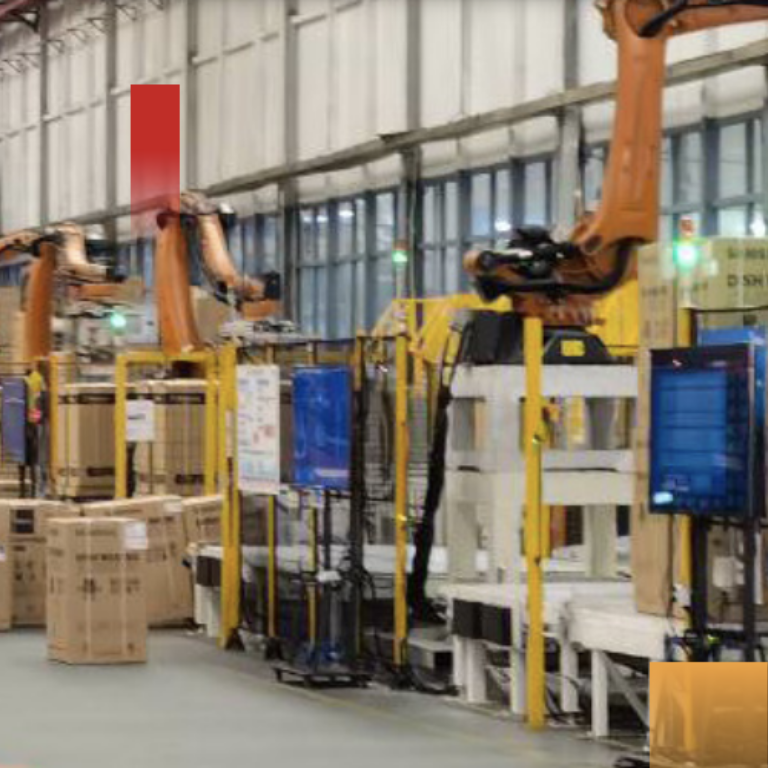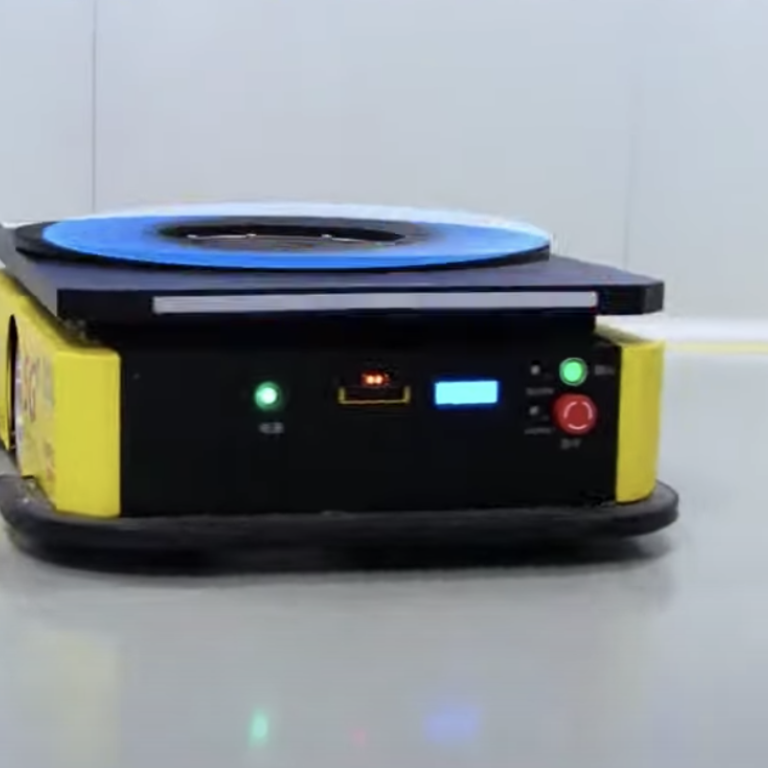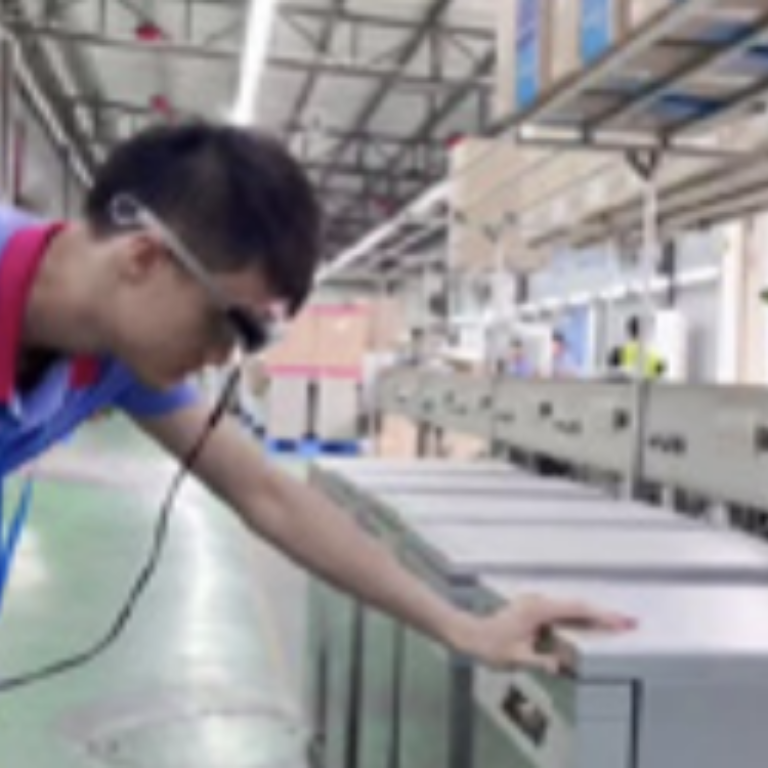5G Transformation Hub
Midea’s Intelligent manufacturing plant
How 5G-enabled industrial IoT can modernise production and operations
Established in 1968, Midea Group is the market-leading home appliance company in China. As part of their ‘full digitization and intelligence’ strategy, they sought to modernise their Kitchen and Water Heater Appliances Division’s factory in Shunde, Guangdong. In collaboration with China Unicom and Huawei, Midea has deployed 5G-enabled Industrial IoT (IIoT) solutions to modernise their manufacturing operation.
Select a project
Contents
Challenge
China's home appliance manufacturing industry is a rapidly growing market and valued at approximately RMB 1.5 trillion. Despite being one of the most advanced manufacturing markets in the world, domestic manufacturers face key inefficiencies in production line technologies and traditional in-plant logistics systems.
Solution
By deploying a combination of customised private networks, edge cloud, and four new platforms (slice management, AI analysis, private network self-service, and integrated positioning), the factory has achieved full 5G coverage and transformed a number manufacturing and business processes.
Impact & Statistics
By the end of 2022 Midea will have applied IIoT technologies to 35 application scenarios in over 2000 locations across the Shunde factory. With a further 55 applications planned in 2023, Midea hopes to fulfil its ambition of setting the national benchmark for interconnected, 5G intelligent manufacturing. Midea estimate that full 5G coverage has reduced the overall running cost of the factory by RMB 32 million per year and led to significant reduction in energy consumption by virtue of streamlining logistics, enhancing equipment management and adopting alternatives to paper.
Wider Implications
: Improving the operation of production units capable of stamping, electronics, injection moulding, powder impregnation, final assembly, and finished products and logistics is likely to see a significant boost in value to China's home appliance manufacturing industry. Moreover, modernisation will improve efficiency, safety and the quality of goods. The project’s success has led to widespread improvements in upstream and downstream supply chain in other areas of the Midea Group, such as Annto Logistics, Midea Wuhu Kitchen and Bath Base and the Midea Foshan Shunde base.
Stakeholders
Midea’s principal partners in this project have been China Unicom and Huawei
02
How 5G-enabled industrial IoT can modernise production and operations
The need to modernise industrial processes with 5G
When planning 5G business scenarios, the company's knowledge and strategy of digital transformation and intelligent manufacturing must be taken into account, as this has a profound impact on understanding of the production process, which in turn helps identify needs and inform top-level plans to deliver more value. During implementation, all parties must cooperate and make good use of each other's skill sets and resources. A good business model should be designed so that providers of network equipment, terminal equipment, application integration, and cloud services can most easily obtain commercial benefits. For new scenarios and new needs, organisations should be prepared to constantly innovate network capabilities (for example, 5G high-precision positioning), and drive technical upgrades and iterations from the business side, helping to form virtuous circles that make it easier to create value in future.
However, as with all digital transformation projects, there are challenges. The cost of transformation to 5G business scenarios and the necessary terminals involved can require significant overhead costs - these can however be reduced through economies of scale. Understanding the industrial production process and designing a 5G network are also specialist and complex exercises. In network design, factors such as latency, bandwidth and reliability must be taken into full consideration to meet business requirements - a process which is far more demanding than traditional network design. After 5G terminals are launched at scale, they also have to be managed in an enterprise-level industry park management platform.
As part of the modernisation of the Shunde plant, Midea first needed to identify scenarios facing critical challenges that could be improved by IoT solutions. In so doing, the organisation focused on those which could be improved with apparent 5G capabilities such as digital twins, increased bandwidth, precise positioning, high reliability and low latency. The organisation found that the combination of 5G networks, edge cloud and AI with deep learning capabilities could address the following critical challenges:
Frequent adjustments to production lines
In the home appliance industry, each order usually contains a variety of products, typically composed of a small number of individual products, which results in regular adjustment of production lines. This is compounded by regular releases of new product iterations, which creates the need for more adjustments. Creating more flexible production lines to reduce cost and labour in this process has been a long-held industry objective.
Disadvantages of traditional in-plant logistics system
Too many operational breakpoints, offline processes and repetitive actions are key areas of logistical inefficiency. Manual operation is required for communicating and recording logistical information, documenting and reporting information on material shortages, confirming material shipping and completing product inventories. Traditional Wi-Fi networks struggle here due to access barriers, disconnection and high latency, all of which compromises the efficiency and accuracy of in-plant logistics and further restricts production.
Strict process requirements and inspection costs of local AI
Manufacturers have to follow strict requirements for production processes and quality control to maintain credibility and market share. Without the necessary 5G-enabled infrastructure, use of AI for quality inspection requires local deployment of dedicated hardware, which is costly and difficult to maintain.
Large quantities of equipment and resulting high operational and maintenance costs
There are over 1,000 pieces of production equipment in a single factory, many of which are imported. Due to the COVID-19 pandemic, equipment manufacturers are unable to dispatch on-site technical support in response to equipment failure, which in turn delays production. In addition, the monitoring of equipment status requires regular manual inspection, which means high labour input and inefficient inspection.

03
How 5G-enabled solutions underpinned intelligent manufacturing
Having identified scenarios which could benefit from transitioning to IIoT, Midea applied 5G solutions effectively transforming each process.
Intelligent module management and cloud-based IPCs for more flexible production
In the stamping process, moulds need to be regularly replaced according to the requirements of different order batches, usually on a daily basis. Typically, staff receive mould location tasks and recommended shelves through the vehicle-mounted tablets, drive forklifts into the shelf area, scan the code to locate the corresponding moulds, then take them out and deliver them to the production lines. Traditionally, the vehicle-mounted tablets were connected through a Wi-Fi network, which was often unstable and regularly disconnected. As a result, the tablets were not always able to receive instructions or scan codes - resolving a single problem can take up to 20 minutes, resulting in low mould delivery efficiency, or even worse, downtime of the production line. By connecting the vehicle-mounted tablets and code scanners through the 5G network, the stability of data transmission is guaranteed. As a result, the time for changing moulds is reduced by more than 20% on average, thereby lowering the production line downtime and improving production efficiency.
Another significant improvement to the manufacturing process was through cloud-based IPCs. There are about 500 IPCs in the Midea factory, which are locally deployed in various workstations. Workers provide product feedback and installation issues to the MES through the UIs on the IPCs. Currently, IPCs are highly priced and generally run much slower after two years of operation. In part, maintenance has to be conducted by the IPC vendor, which can be costly. In addition, frequent production line adjustments to meet the order requirements necessitates local deployment of a large number of servers and network cables, resulting in higher production costs. Moreover, as IPCs connect and interact with the interfaces of SCADA and MES, they become more difficult to debug and maintain. Midea’s factory virtualises the IPCs on the MEC locally to connect code scanners, screens, terminals and the edge cloud to enable centralised management of operations and maintenance. This reduces the cost of deploying IPCs locally, improves the efficiency of operations and maintenance, and vastly decreases deployment of network cables, creating much more flexible production lines in the process.
Intelligent in-plant logistics
The 5G in-plant intelligent logistics system adopts advanced positioning for real-time and accurate positioning of key elements such as trucks, forklifts and tractors to obtain the location and status of vehicles and cargo. It also matches the physical logistics with the information flow in Midea’s manufacturing execution system (MES) and warehousing management system (WMS) to realise real-time display of cargo information, automatic inventory, consistent accounting and intelligent management. Compared with traditional single-positioning technology, this system features wide integration and fast switching, which can meet the various complex needs of each production area, further improve positioning accuracy, reduce environmental dependence and network latency, and connect data silos. At the same time, compared with the current mode of automation, this system features lightweight and low-cost deployment and much greater overall flexibility.
The 5G-enabled positioning system uses Midea’s existing 5G network coverage to obtain wireless signals from terminals through the base stations of digital indoor systems, and deploys positioning algorithms on the edge cloud to calculate the results through dynamic filtering algorithms. Finally, these results are reported to Midea’s various applications through the standard interfaces. This intelligent network, which comes without additional network building or maintenance, serves multiple purposes and features low building cost, high bandwidth, low latency, and wide coverage to support the positioning of a large number of factory terminals.
The 5G intelligent logistics solution has helped Midea achieve labour efficiencies, saving RMB 8.89 million in labour costs and RMB 100,000 in paper costs, and has directly increased profits by RMB 1.74 million. This solution has been deployed in various parts of the business such as Annto Logistics, Midea Wuhu factory, and Midea production bases, increasing both efficiency and value in the manufacturing chain through end-to-end 5G intelligent logistics. The widespread application of this solution will further boost the capabilities of 5G positioning and industry maturity, and contribute to the formulation of industry standards for 5G positioning by the ISO.
5G-enabled AR and AI for remote and high quality inspection
Goods produced to order cannot be released for shipping until customers have undertaken an on-site inspection, which often causes a backlog of goods. However, on-site operators equipped with 5G AR glasses can communicate videos and information to customers in real time, providing an alternative to on-site inspection and acceptance, thus improving the stock turnover.
Alongside AR, 5G has enabled significantly improved AI quality inspection methods. In various production lines such as electronics, metal plates and assembly, it is necessary to conduct quality checks on many intermediate parts and processes such as PCBs, metal plates, label positions, bottom plate screws, and manual inspection actions. Traditionally, quality inspections are performed manually, which are liable to human error resulting in unpredictable inspections and higher cost. Alternatively, quality inspections can be conducted through AI algorithms in locally deployed servers, but this has also come at a high cost due to equipment procurement, deployment of network cables, operation and maintenance, and high energy consumption. However, with 5G and AI terminal-edge-cloud architecture, photo information is collected using HD industrial cameras on the terminal side, inference operations are conducted with the MEC on the edge side, and AI data training is performed on the cloud. 5G’s high bandwidth and low latency results in rapid quality inspections and interactions with the MES. Additionally, 5G automates determination of unqualified goods and automatic alarms during scanning which, as well as being far more efficient use of server resources, helps to improve product quality, alleviate manual inspection of workstations and reduce repair cost.
Predictive maintenance and AR remote assistance
The powder impregnation lines are imported and need on-site guidance and maintenance by foreign experts in case of any equipment failures. However, it is challenging for foreign experts to arrive on site since the COVID-19 pandemic, resulting in high maintenance and repair costs, longer downtime of equipment, and overall lowered production efficiency. Manual spot checks on the production equipment in all workshops, which are conducted twice a day, can also be improved upon. In a single workshop, there may be hundreds of items to be checked - the heavy workload of inspectors could easily lead to improper checks, which could otherwise be made more accurately and recorded in greater detail with machine assistance.
5G networks have provided fundamental improvements. Firstly, they can be used to monitor the status of parameters of the powder impregnation lines and analyse equipment to anticipate outage. The maintenance schedule can be formulated in advance to ensure early detection and prevention of hidden dangers and defects. AR technology can support simultaneous translations of multiple languages due to 5G’s large bandwidth, low latency and high quality, enabling real-time remote examination and guidance by foreign experts.
Improvements to industry park management
Industry park security relies on inefficient manual controls and management without visualised management and an effective means of early warning and alerts. However, 5G cameras and sensors deployed in the industry park enable real-time data collection across the park, significantly improving early warning and alert methods. The industry park security, fire protection, environmental protection, and other systems are connected for intelligent management. 5G networks can boost security in a number of specific ways:
● 5G intelligent cameras are installed in key areas of the industry park to photograph and record illegality
● Sensors and infrared cameras are put in place to monitor high fire hazard zones in the industry park
● 5G mobile AI monitoring equipment is used to monitor temporary constructions at different sites
● The on-site monitoring equipment is connected with the EHS system to send the monitoring results to the system and use it for event recording, early warning and control. This solution has been demonstrated to reduce the accident rate in the industry park by 12% and review and approval time of dangerous operations by 90%, all of which helps lower overall security costs.
This collaborative project between Midea Group, China Unicom and Huawei shows how 5G IIoT can transform a number of critical processes across the manufacturing setting. Having completed the first phases of industrial transformation, Shunde are seeking to develop their IIoT capabilities in a number of ways:

04
Next steps for Midea’s Shunde factory
- Expanded connections: based on the map of 5G digitalisation of the factory, network connections and application scenarios will be further expanded to connect over 2,000 terminals by 2022
- Increase application scenarios: 5G positioning will be examined in more detail and used in more application scenarios. We will conduct more research into terminals to help achieve higher more precise positioning and lower power consumption with the aim of creating the benchmark for positioning
- More reliable private networks: in response to the demand for high reliability and SLAs for private networks, we will continue to launch and innovate highly reliable private network solutions such as slicing, dual transmission and selective-receiving mode, and continuous MEC that can operate in the event of disconnection. We will also build an industry park self-service platform, improve unified management monitoring and fault detection within the private network
- Concentration of services on the edge: based on the operator MEC, AI quality inspection, AR remote maintenance and other services will be centralised on the edge cloud. We will also investigate centralisation of production control equipment such as PLCs and IPCs on the cloud to further synergise industrial operations with other areas of business
- Empowering the industry: by continually innovating Midea’s industrial internet platform, we gain more insight into the needs of organisations across the ecosystem, ultimately helping us fulfil our aim of creating the benchmark for IIoT deployments and playing a leading role in modernising manufacturing

05
About
About the GSMA
The GSMA is a global organisation unifying the mobile ecosystem to discover, develop and deliver innovation foundational to positive business environments and societal change. Our vision is to unlock the full power of connectivity so that people,
industry, and society thrive. Representing mobile operators and organisations across the mobile ecosystem and adjacent industries, the GSMA delivers for its members across three broad pillars: Connectivity for Good, Industry Services and Solutions, and Outreach. This activity includes advancing policy, tackling today’s biggest societal challenges, underpinning the technology and interoperability that make mobile work, and providing the world’s largest platform to convene the mobile ecosystem at the MWC and M360 series of events.
For more information, please visit the GSMA corporate website at www.gsma.com.
Follow the GSMA on Twitter: @GSMA.
GSMA 5G Transformation Hub
The GSMA 5G Transformation Hub is a source of information on some of the most innovative 5G solutions in the world. This portal contains case studies detailing design, benefits, key players, measured value and the future impact of scaling up these 5G solutions worldwide. The 5G Era is now firmly established and this family of standardised GSM technologies, including mmWave, are being rolled out successfully across the globe. The GSMA 5G Transformation Hub, launched at MWC Barcelona in 2022, provides details of how 5G is best placed to deliver real value for a range of key sectors including manufacturing, energy, transportation, media and live entertainment, smart cities and construction.. Many more case studies will be added, in the coming months, covering even more industries and the GSMA is asking Members to nominate innovative 5G case studies to add to this global digital showcase. The 5G Transformation Hub and this particular Case Study are both sponsored by Qualcomm.
About this case study
This case study is for information only and is provided as is. The GSM Association makes no representations and gives no warranties or undertakings (express or implied) with respect to the study and does not accept any responsibility for , and hereby disclaims any liability for the accuracy or completeness or timeliness of the information contained in this document. Any use of the study is at the users own risk and the user assumes liability for any third party claims associated with such use.